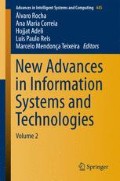Abstract
In recent years the use of mobile technology has become very common and popular. It is important to provide correct and useful nutritional information to diabetic patients, which can be easily accessed by mobile technology. However, providing such information to patients using mobile application is limited. One method is to use mobile technology, which is a very effective method in the expansion of information process visually, especially in health-related areas by using mobile devices. Therefore, the integration of mobile application with Diabetes management can provide useful nutritional and health information in order to improve the lifestyle of diabetic patients. This paper presents a comprehensive review of the state of the art in mobile application for Diabetes management.
Access this chapter
Tax calculation will be finalised at checkout
Purchases are for personal use only
Preview
Unable to display preview. Download preview PDF.
References
Kikuno, “Why do software projects fail? Reasons and a solution using a Bayesian classifier to predict potential risk”, 11th IEEE Pacific Rim International Symposium, 2005
M. Z. Bayu, H. Arshad, and N. M. Ali, “Nutritional Information Visualization Using Mobile Augmented Reality Technology,” Procedia Technol., vol. 11, no. Iceei, pp. 396–402, 2013
S. Irshad, “User Experience Evaluation of Mobile AR services,” 2014
F. Zhou, H. B. L. Dun, and M. Billinghurst, “Trends in augmented reality tracking, interaction and display: A review of ten years of ISMAR,” in Proceedings - 7th IEEE International Symposium on Mixed and Augmented Reality 2008, ISMAR 2008, 2008, pp. 193–202
D. Bunma, “Using Augment Reality to Increase Capacity in QR Code,” IEEE, pp. 440–443, 2014
M. H. Rahman, M. Pickering, M. Frater, D. Kerr, C. Bouchey, and E. Delp, “Food Volume Estimation in a Mobile Phone Based Dietary Assessment System,” 2012 Eighth Int. Conf. Signal Image Technol. Internet Based Syst., pp. 988–995, Nov. 2012
W. T. Leader, “Designing Mobile Applications to support type 1 diabetes education,” 2012
E. Arsand, J. T. Tufano, J. D. Ralston, and P. Hjortdahl, “Designing mobile dietary management support technologies for people with diabetes.” J. Telemed. Telecare, vol. 14, no. 7, pp. 329–332, 2008.
O. El-Gayar, P. Timsina, N. Nawar, and W. Eid, “Mobile applications for diabetes self-management: status and potential.,” J. Diabetes Sci. Technol., vol. 7, no. 1, pp. 247–62, 2013.
A. P. Demidowich, K. Lu, R. Tamler, and Z. Bloomgarden, “An evaluation of diabetes self-management applications for Android smartphones,” Journal of Telemedicine and Telecare, vol. 18, no. 4. pp. 235–238, 2012.
M. Arnhold, M. Quade, and W. Kirch, “Mobile applications for diabetics: A systematic review and expert-based usability evaluation considering the special requirements of diabetes patients age 50 years or older,” Journal of Medical Internet Research, vol. 16, no. 4. 2014
T. Chomutare, L. Fernandez-Luque, E. Arsand, and G. Hartvigsen, “Features of mobile diabetes applications: Review of the literature and analysis of current applications compared against evidence-based guidelines,” Journal of Medical Internet Research, vol. 13, no. 3. 2011
M. M. Anthimopoulos, L. Gianola, L. Scarnato, P. Diem, and S. G. Mougiakakou, “A Food Recognition System for Diabetic Patients Based on an Optimized Bag-of-Features Model,” IEEE J. Biomed. Heal. Informatics, vol. 18, no. 4, pp. 1261–1271, Jul. 2014.
A. C. Valdez, M. Ziefle, A. Horstmann, and D. Herding, “Mobile devices used for medical applications : Insights won from a usability study with diabetes patients,” Int. J. Digit. Soc. (IJDS), vol. 2, no. 1, pp. 337–346, 2011.
D. Preuveneers, Y. Berbers, and W. Joosen, “The future of mobile e-health application development: Exploring HTML5 for context-aware diabetes monitoring,” Procedia Comput. Sci., vol. 21, pp. 351–359, 2013.
S. H.-M. Guo, H.-K. Chang, and C.-Y. Lin, “Impact of Mobile Diabetes Self-Care System on patients’ knowledge, behavior and efficacy,” Comput. Ind., vol. 69, pp. 22–29, 2015.
D. K. King, D. J. Toobert, J. D. Portz, L. a. Strycker, A. Doty, C. Martin, J. M. Boggs, A. J. Faber, C. R. Geno, and R. E. Glasgow, “What patients want: relevant health information technology for diabetes self-management,” Health Technol. (Berl)., vol. 2, no. 3, pp. 147–157, 2012
K. Patrick, W. G. Griswold, F. Raab, and S. S. Intille, “Health and the Mobile Phone,” American Journal of Preventive Medicine, vol. 35, no. 2. pp. 177–181, 2008.
F. Kong and J. Tan, “DietCam: Automatic dietary assessment with mobile camera phones,” Pervasive Mob. Comput., vol. 8, no. 1, pp. 147–163, 2012.
A. G. Ershow, J. O. Hill, and J. T. Baldwin, “Novel engineering approaches to obesity, overweight, and energy balance: public health needs and research opportunities.,” Conf. Proc. IEEE Eng. Med. Biol. Soc., vol. 7, pp. 5212–5214, 2004
O. Amft and G. Tröster, “On-body sensing solutions for automatic dietary monitoring,” IEEE Pervasive Comput., vol. 8, no. 2, pp. 62–70, 2009.
P. Klasnja and W. Pratt, “Healthcare in the pocket: Mapping the space of mobile-phone health interventions,” J. Biomed. Inform. vol. 45, no. 1, pp. 184–198, 2012.
S. L. Mansar, S. Jariwala, M. Shahzad, A. Anggraini, N. Behih, and A. AlZeyara, “A Usability Testing Experiment For A Localized Weight Loss Mobile Application,” Procedia Technol., vol. 5, pp. 839–848, 2012.
N. Wiwatwattana, S. Sukaphat, and T. Putwanpen, “Augmenting for Purchasing with Mobile : Usage and Design Scenario for Ice Dessert,” vol. 2557, no. 095, 2003
P. Meda, M. Kumar, and R. Parupalli, “Mobile Augmented Reality Application for Telugu Language Learning,” pp. 183–186, 2014
Author information
Authors and Affiliations
Corresponding author
Editor information
Editors and Affiliations
Rights and permissions
Copyright information
© 2016 Springer International Publishing Switzerland
About this paper
Cite this paper
Butt, S.M., Navarro, K.F., Shorab, M., Butt, S.M., Onn, A. (2016). Using Mobile Technology to Improve Nutritional Information of Diabetic Patient’s. In: Rocha, Á., Correia, A., Adeli, H., Reis, L., Mendonça Teixeira, M. (eds) New Advances in Information Systems and Technologies. Advances in Intelligent Systems and Computing, vol 445. Springer, Cham. https://doi.org/10.1007/978-3-319-31307-8_1
Download citation
DOI: https://doi.org/10.1007/978-3-319-31307-8_1
Published:
Publisher Name: Springer, Cham
Print ISBN: 978-3-319-31306-1
Online ISBN: 978-3-319-31307-8
eBook Packages: EngineeringEngineering (R0)

